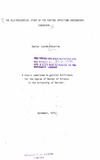| dc.description.abstract | An electrochemical study of some of the factors affecting the
corrosion of steel in soils has been carried out. The factors studied
were oxygen diffusion rates, soil moisture content, soil resistivity,
salt concentrations, pH and bacteria activity. The soils studied
ranged from pure sand, clayeous sand, clay and peat, obtained from
different places in Trondheim. The corrosion rates of steel were
determined by means of polarization and weight loss measurements.
The presence and rate of transport of oxygen in a soil appears
to be the most important factor. The corrosion rate of steel in soils
studied, like in many neutral electrolytes is determined by the dissolved
oxygen content available at the surface of the metal, and any
factor affecting diffusion of oxygen has been found to have a marked
effect on the corrosion, rate. -Unequal distribution of oxygen occurred
in dry ·or porous soils where a nonuniform condition of the soil aggregate
existed land in soils of varying moisture and salt contents .
.Such conditions have been found to give rise to local galvanic action
on buried steel specimens.
In most soils, the maximum rate of corrosion has been found
to occur when the soil was moist rather than wet or saturated and
when the salt concentration was low ratner than high. The cathodic "-~
oxygen reduction bas been found to be highest when soils (ranging
from pure sand to clay) contained between 15 and 30% moisture. This
coincided with the point of maximum corrosion rate, implying that
the oxygen reduction was the corrosion rate determining reaction.
In peat soil, the maximum cathodic activity occurred when there was
80% moisture. The rate of corrosion of steel decreased in saturated
or "salty" soils because of the limited supply of oxygen.
The increase in salt content results in a decrease in electrical
resistivity and the oxygen diffusion rates. It has been found
that in increasing the salt content of the soil, the corrosion rate
increased up to a point, after which it dropped, probably due to
reducing of the oxygen availability. The study reveals that it is not
possible to categorize soils into aggressive and non aggressive based
on analysis of the individual properties. | en |

